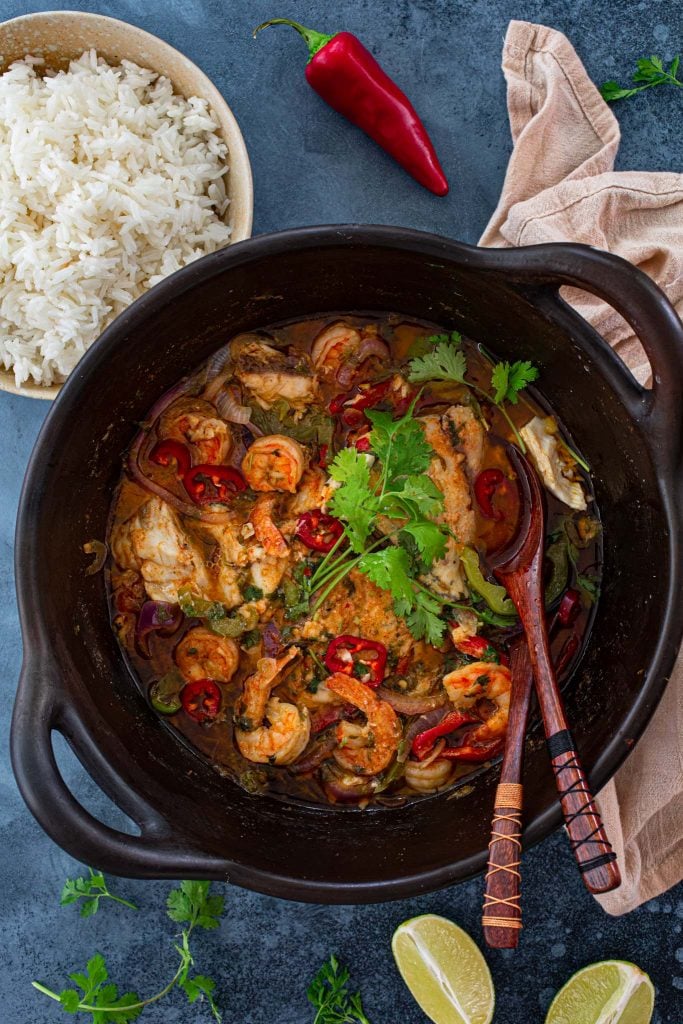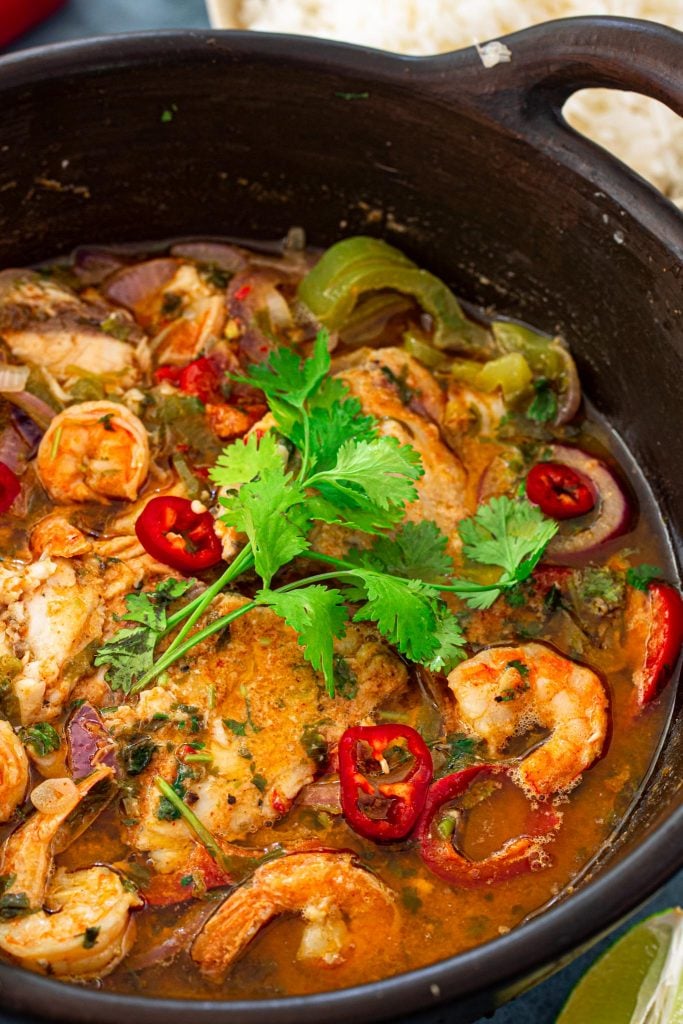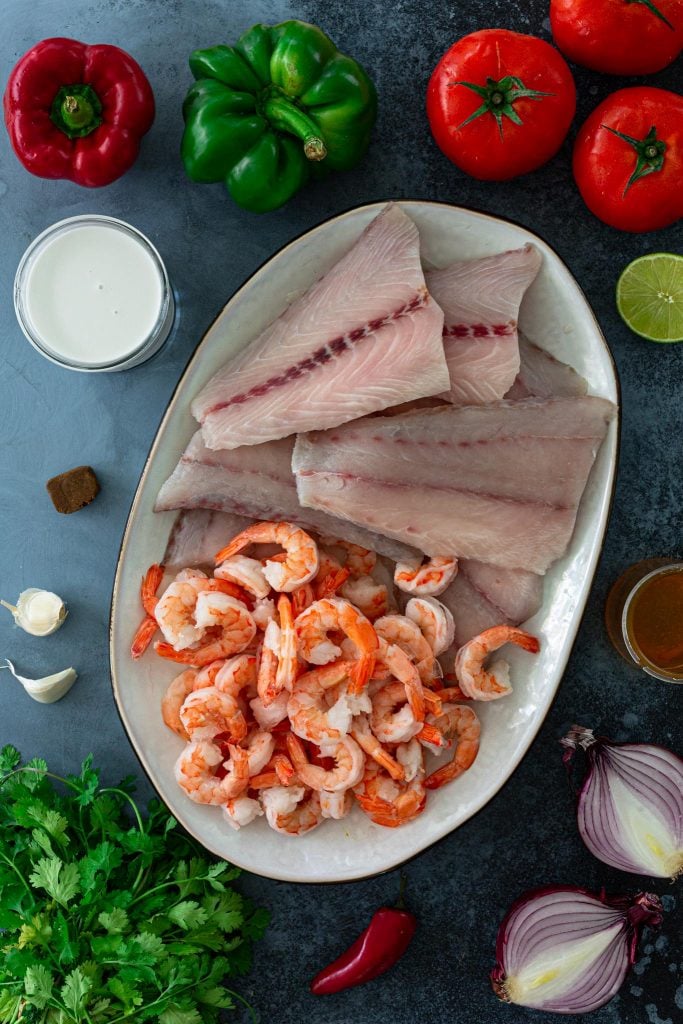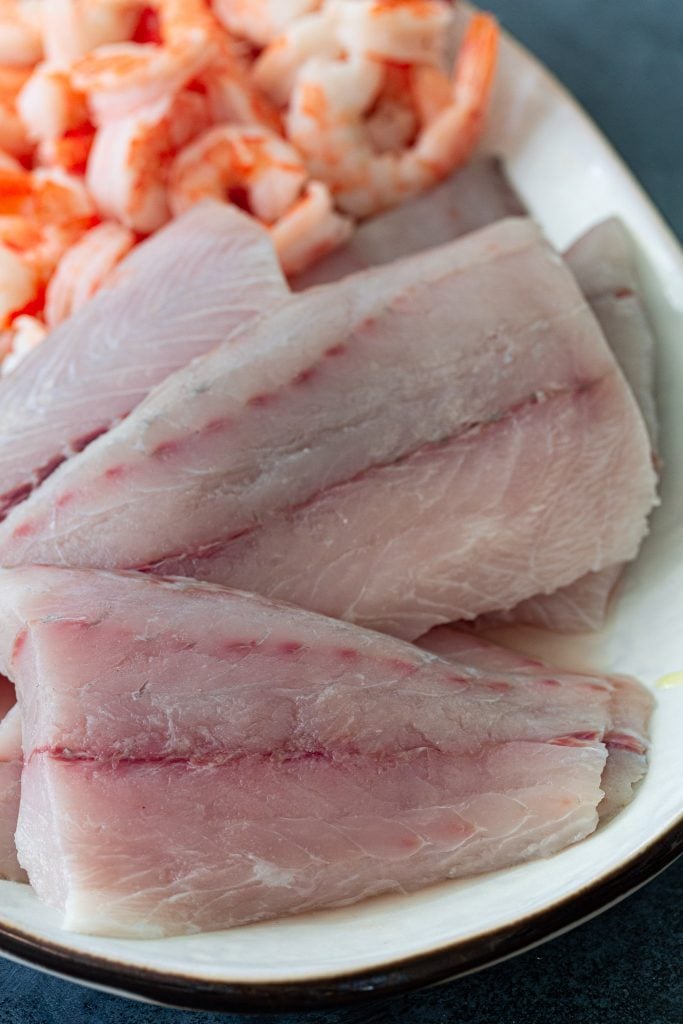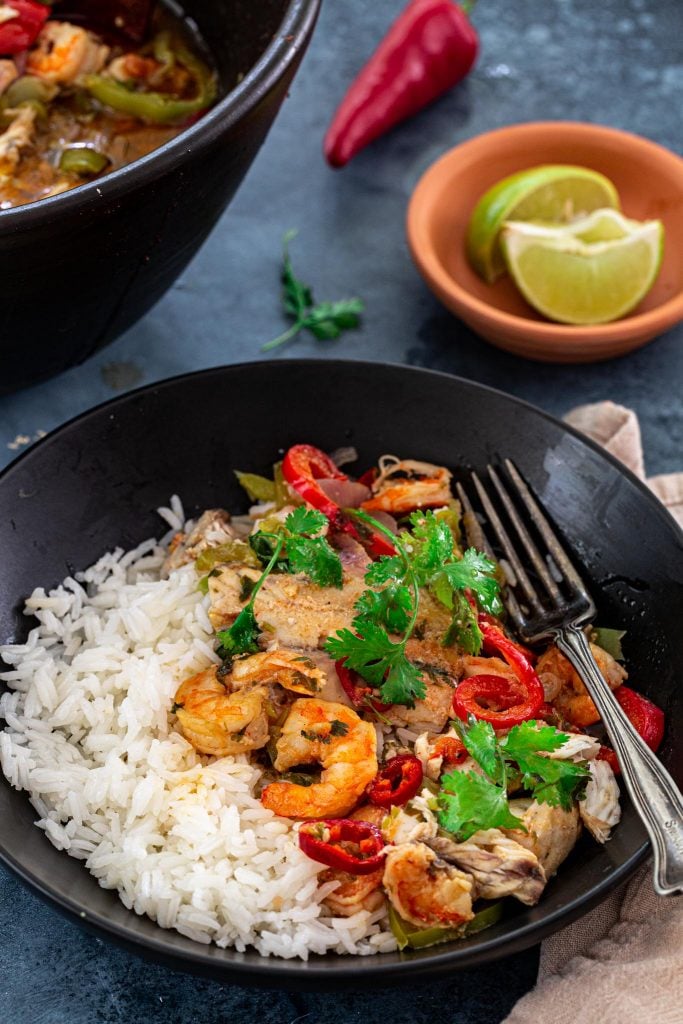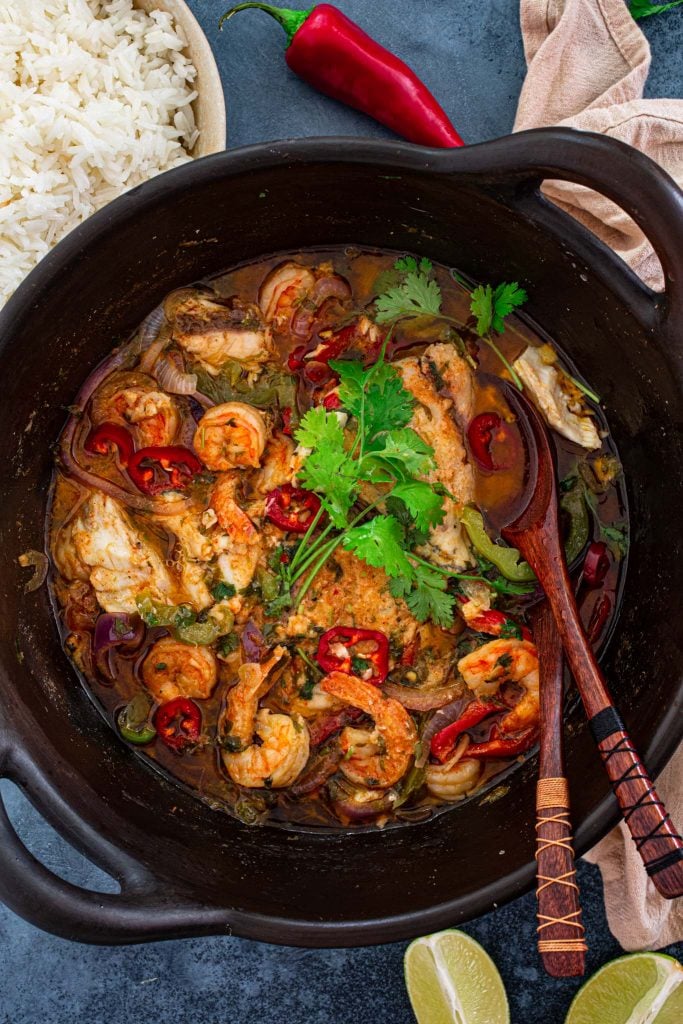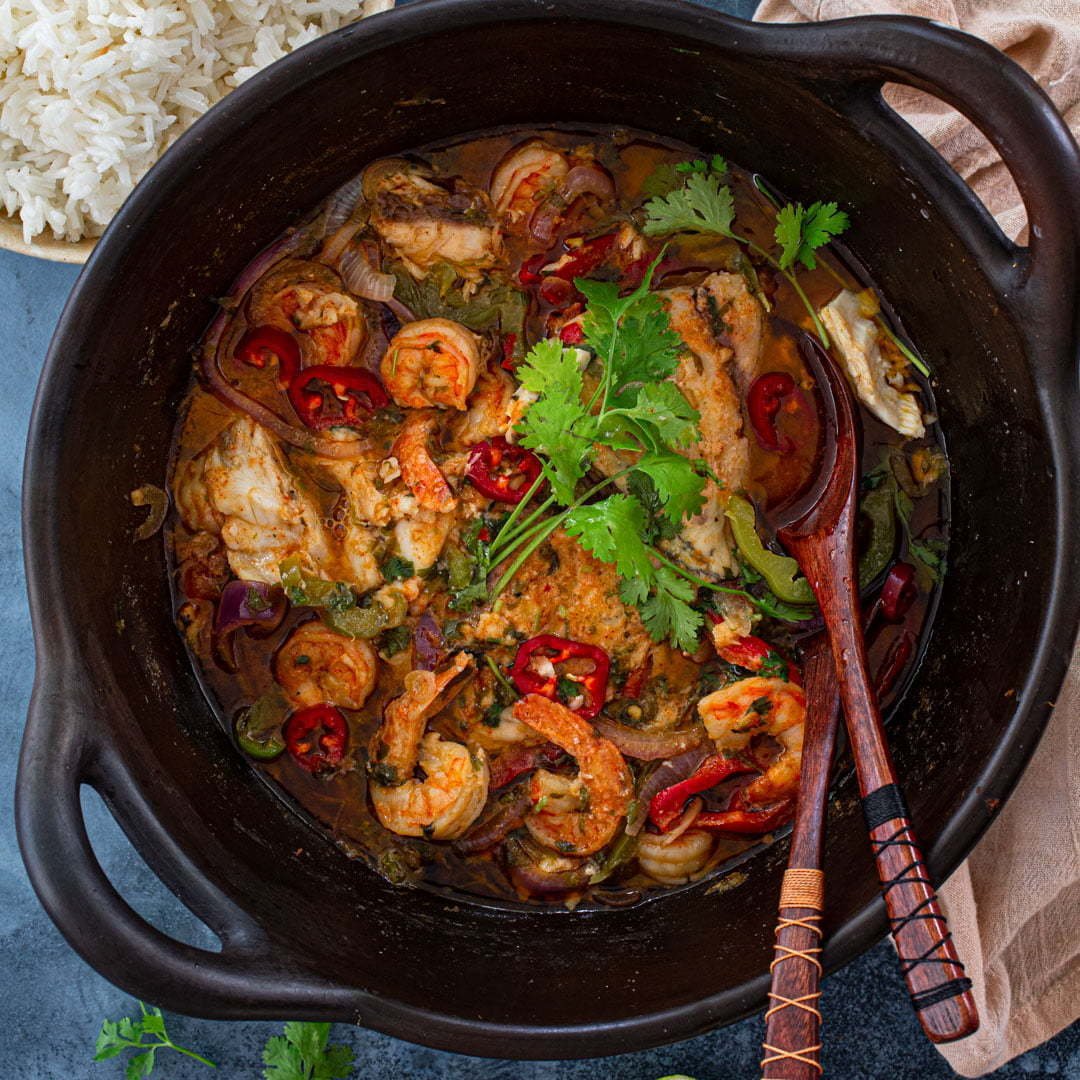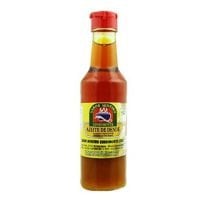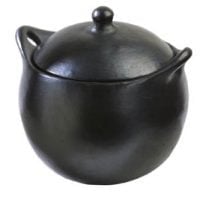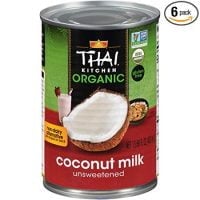It’s here, y’all! The infamous MOQUECA BAIANA. Can you believe it? You guys have been asking me for this recipe for years and I finally delivered. My mom was staying with us, visiting from Brazil, and I thought it was the perfect opportunity to learn how to make it. Fish and seafood are not my forte, so it was great to have her around to make sure I got it right! I found that buying the proper fish was hard (but more on that later) and I also had to order azeite de dendê (palm oil) online. But, if you don’t mind it not tasting authentic, you can certainly make it without it – just don’t tell my mom! Once you have the ingredients, the dish is quite easy to make and cooks fast too. You can have it on the table in less than 30 minutes!
What is Moqueca?
Moqueca (pronounced mo-keh-kah or moo-keh-kah) is one of the classics of Brazilian Cuisine. It is a fish-based stew, often cooked in a clay pot, famous for its aromatic broth. There are also versions made with chicken, beef or vegetarian/vegan. The dish was born from the indigenous pokeka, a method of cooking fish that native Brazilians used, where the fish was wrapped in banana leaves and then roasted over coals. From there, the moqueca slowly transformed, influenced by the cooking habits of each region. In the North, it became the Moqueca Baiana, where it gained elements of the African culture, while in the Southeast it became the Moqueca Capixaba, heavily influenced by the Portuguese and Spanish.
What is the difference between Moqueca Baiana and Moqueca Capixaba?
The Moqueca is the subject of one of the biggest culinary rivalries in Brazil. The two dueling regions are Bahia and Espírito Santo, both claiming to make the best moqueca in the country. Both of them include garlic, tomatoes, cilantro, onions, salt and olive oil. The difference is that the Moqueca Baiana also calls for bell peppers, palm oil and coconut milk – ingredients that are not part of the capixaba version. Which one is the best, you ask? Well, you will get a different answer depending on which Brazilian you ask. My mom swears by the baiana while my sister in law swoons over the capixaba. Me? I find them to be two different beasts: one bold and complex, just like the people in Bahia, and the other gentler and lighter, more suitable for sensitive palates.
Ingredients for Brazilian Fish Stew
Here’s what you’ll need to make a killer Moqueca Baiana:
A firm white fish Shrimp Tomatoes Green and red bell peppers Red Onion Garlic Lime Cilantro (or parsley if you’re a cilantrophobe!) Red chili pepper (or red pepper flakes, if you can’t find it) Coconut Milk Dendê (Red Palm) Oil Olive Oil Fish, shrimp or vegetable bouillon Salt and pepper
Make sure you buy the freshest and highest quality ingredients that you can afford. You probably won’t find the red palm oil in your local grocery store, so I recommend ordering online!
What kind of fish should I use?
You can make moqueca with several different kinds of fish and seafood. There is only one rule: the fish can’t fall apart, it has to keep its structure during cooking. A firm white fish is what you should look for. My mom gave me a list of fishes that would work and off to the grocery store I went. I almost never buy fish, so I stood in front of the fish counter, probably looking a bit desperate, until someone took pity on me and came to help me out. After I explained what I was looking for (with the help of Google translator, since my mom gave me the names in Portuguese), the lady showed me what was available: all fillets or steaks, no whole fishes or – like my mom advised me to buy – postas (which are big chunky pieces). I left, went to another store that also didn’t have anything I was looking for at the fish counter, and ended up finding frozen seabass that looked like chunks. Back at home, once we opened the bags, we found out they were fillets. Mom cursed me out a little bit, but in the end it worked just fine! Moral of the story? Try to find a place that will cut a fresh whole fish into chunks for you (or DIY if you have those skills), but if all you can find are fillets, just go for it! You will have to pay extra attention so it doesn’t fall apart, but it will still be delicious. Here are some kinds of firm white fish that will work for this recipe:
Seabass Whiting Fish Mahi Mahi Fresh Cod or Haddock Grouper Dogfish
As for the shrimp, I ended up buying the precooked ones because they looked bigger and juicier, but moqueca is usually made with raw. Note: if using frozen fish and/or shrimp, make sure to thaw before seasoning it.
How to serve Brazilian Moqueca?
Brazilian Fish Stew is always served with white rice. And, if you’re going to make moqueca, you should make sure you spend the extra 5 minutes it takes to make rice the Brazilian way. I promise you won’t regret it! You can also make pirão de peixe – a savory porridge made with fish broth and cassava flour – and/or farofa (toasted cassava flour). I also like to serve it with lime wedges, so my guests can squeeze some lime juice for an extra touch of freshness!
Tips and tricks to make Moqueca Baiana:
Traditionally, moquecas are made (and served) in clay pots. Clay pots’ porous nature allows both moisture and heat to circulate through the food, so the stew will cook slowly and evenly. However, if you don’t own one (and don’t want to invest in one), you can use a dutch oven instead. Once you cover the pot and lower the heat, refrain from stirring the stew to prevent the fish from falling apart. Despite it being a stew, moqueca cooks for only about 15 minutes. Anything more than that and you’ll end up with shredded fish and rubbery shrimp. If, at the end, your broth is too liquidy, you can mix a teaspoon of cornstarch with some water and add to the moqueca. Then cook until it thickens to the desired consistency. You can garnish with chopped (or torn pieces) of cilantro and some sliced red chili peppers.
Other Brazilian Cuisine classics:
Pão de Queijo (Cheese Bread)BrigadeiroCoxinhas (Chicken Croquettes)Pastel (Brazilian Empanadas)Hearts of Palm SaladEmpadão de Frango (Chicken Pot Pie)Feijão Tropeiro
Dende Oil Clay Pot Coconut Milk

